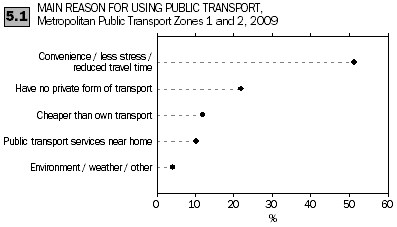 PUBLIC TRANSPORT
PUBLIC TRANSPORT
This chapter presents information about the use of public transport for individuals in Melbourne1.
Both the federal and Victorian governments have recently introduced policies aimed at supporting an increase in public transport use. In 2009, the federal government identified climate change leading to an increased demand for improved infrastructure, such as efficient public transport systems, as one of the key challenges facing Australia (IA 2009). The Victorian government has placed a priority on actions to support a rapid modal shift over the next five years from car to public transport (DPCD 2008), and plans to move towards a sustainable and lower emissions transport system to support a greener Victoria (DoT 2008).
Melbourne's public transport network is divided into two main zones. Melbourne Metropolitan Public Transport Zone 1 covers the city centre and most inner suburbs of Melbourne, while Melbourne Metropolitan Public Transport Zone 2 covers most of the outer suburbs.
Of the 3 million people (aged 18 years and over) living in Melbourne Metropolitan Public Transport Zones 1 and 2, 1.1 million (37%) used public transport in the last month. Of those who used public transport in the last month, 499,000 people (45%) usually used public transport three to seven days a week.
Zone 1 had a higher proportion of public transport users in the last month (55%) than Zone 2 (28%). Zone 1 also had a higher proportion of frequent public transport users (people usually using public transport three to seven days a week), with 28% compared with 11% in Zone 2.

Of the 1.1 million people who used public transport at least once in the previous month, the main reason most given for using public transport was that it was more convenient than their own transport, it was less stress or it reduced their travel time (51%). Other reasons given were that they had no private form of transport (22%), it was cheaper than their own transport (12%), and they had public transport services near home (10%).
Although 'more convenient than own transport, less stress or reduced travel time' was the most common main reason given for using public transport, only one-third (34%) of those people usually used public transport three to seven days a week. The main reasons given for people who usually used public transport three to seven days a week were that they had no private form of transport (60%), they had public transport services near their home (59%), or it was cheaper than their own transport (59%).
People whose household income was $110,000 or more a year were more likely (64%) to give a main reason that it was more convenient than their own transport, less stress or reduced travel time than people whose household income was less than $25,000 per year (32%). People whose household income was $110,000 or more per year were also less likely to give a main reason that they had no form of private transport (8%) than people whose household income was less than $25,000 per year (36%). The proportion of people who stated public transport services near their home as their main reason was higher in Zone 1 (12%) than in Zone 2 (8%).
The main reason most given for not using public transport (by those people who did not use public transport in the last month) was that a company vehicle was available or needed, or a private vehicle was preferred (73%). Other reasons given were that public transport services were inadequate, inconvenient or unavailable (21%), there was no need to use public transport (3%), and they preferred to walk or cycle (2%).
References
DoT (Victorian Government Department of Transport) 2008, The Victorian Transport Plan, The State of Victoria, Melbourne.
DPCD (Victorian Government Department of Planning and Community Development), 2008, Planning for all of Melbourne, The State of Victoria, Melbourne.
IA (Australian Government Infrastructure Australia) 2009, National Infrastructure Priorities, Commonwealth of Australia, Canberra.
1 The scope of the public transport chapter includes only people aged 18 years and over usually residing in Metropolitan Public Transport Zones 1 and 2 within Melbourne MSR. Metropolitan Public Transport Zones 1 and 2 cover 98% (3.0 million) of the population of the Melbourne MSR (3.1 million). For more information, refer to the Glossary, Downloads 'Melbourne Metropolitan Public Transport Zones 1 and 2' and Explanatory Notes.
 Print Page
Print Page
 Print All
Print All
 Print Page
Print Page
 Print All
Print All